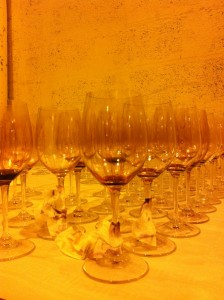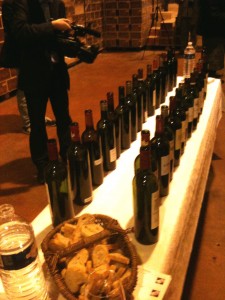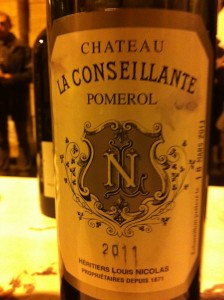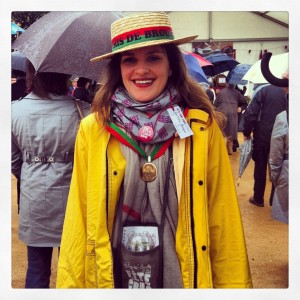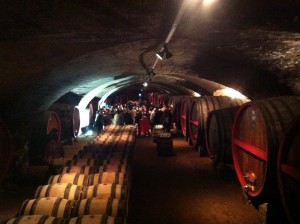The first tasting I want to talk about is one of my favourite tastings in Bordeaux. It is an en Primeur tasting – but not your traditional one. The tasting still consists of barrel samples, but the wines are about 18 months old (rather than a mere 6 months). That is why I think of it as a “en primeur tasting avec recul” or a delayed en primeur tasting.
I find this tasting interesting as the wines are very close to being bottled, and after about 18 months of (oak) aging they are a little easier to taste and evaluate but we have to remember that they are still mere toddlers and will need quite a bit more time.
The tasting is organised by Millisema – a large Negociant in Bordeaux – and takes place in their famous chai store rooms in between the many cases of famous Cru Classée wines.
A big part of why I really enjoy this tasting is that it covers the whole of Bordeaux and is organized per region which makes makes it really easy to form an opinion on the vintage qualities of a certain place and compare notes on the different sub regions. The line up is the same in both sides of the table – which allows to easily taste the same wine from a different bottle and compare notes. Speaking of the line up – it is pretty impressive as most of the renowned Chateaux participate and a lot of the people at the tasting are insiders (Chateau owners or Bordeaux wine makers) who are interested in comparing notes but also readily share experiences. It is not very often that one has the opportunity to ask direct questions about Bordeaux’s second to fifth Growth wines to the winemaker and compare answers as one goes along. For me the learning curve was pretty steep:-)The only slight negative about the tasting is that it is rather quick – one has just over one and a half hours to taste through 150 samples… Having said that I am not too sure how many tasters (which were all trade and press) would manage to work their way through all the wines even with more time. I chose to taste a 4-6 wines per region and generally went on recommendations of others or on notes I had taken the year before at the 2011 En Primeurs.
So what are my conclusions on 2011, a difficult vintage in more than one sense of the word. After the awesome 2009 and some say even better 2010 vintage which both commanded crazy prices, everybody was watching what would happen in 2011. The fact that the weather played havoc and caused a lot of damage just around vintage did not help this cause; in fact the vintage was just about written off by investors and press alike at a time that wine making had only just begun. Needless to say the “En Primeur” campaign was notoriously difficult, and several negociants really struggled to shift even half the amount of cases of what they had done in the last few years.
According to Patrick Bernard, CEO and part owner of Millisema, the En Primeur system grinded to a halt in May/June 2012. He blames the pricing and the uncertain market. In the light of the sky rocketing prices, it was obvious prices had to come back down, but he feels they did not come down enough to entice buyers to invest in a difficult vintage. Bernard told me that “the system of En Primeur is all based on value – the customer believes he is getting a great deal by buying a wine which is not finished yet, and the Chateaux sell the wine below value to help with the cash flow. Unfortunately as lots of people heavily invested in sorting procedures – either through buying really expensive equipment or investing in more people to go through the grapes several times -the cost of production had been significantly higher than the previous years. This was partly reflected in the price which did go down, but not as much as the public expected. As a result fewer people invested believing prices would come down further down the line.” Bernard continued by stating that the prices would have to come down more for the 2012 vintage – which is not considered a great vintage either but on average better than 2011.
But besides this doom and gloom I am very happy to say that I did taste some very promising wines. In general the wines with more Merlot in the blend (very generally speaking the right bank) showed better than their Cabernet Sauvignon based counter parts. A big reason for this is that Merlot ripens earlier than Cabernet, so a lot of it was harvested before the bad weather hit. Another reason could be that Merlot is more seductive when young than Cabernet Sauvignon, which tends to be more austere.
I focused on the region of Pomerol as I was to visit the region after the tasting for an article which will appear in Snooth in June and found overall the wines quite lifted and elegant. There was an evident freshness in all the samples I tasted. Favourites were Chateau La Conseillante, with wonderful floral and red fruit notes, Chateau l’Evangile, very elegant and integrated wine just about ready to drink now and Chateau le Gay – very layered and complex which kept on surprising me.Some other favourites of the tasting were Chateau Pape Clement – I really have a soft spot for this wine as I seem to pick it out time after time – but even in its youth this Pessac-Léognan was seductive with its intense black fruit notes and quite round and balanced in the finish.
I found the Margaux wines still very closed but was pleasantly surprised by Chateau Palmer and Chateau Giscours. In St Julien I had 3 stars next to Chateau Lagrange and in St Estephe I quite like Chateau Montrose.
St Emillion was just as Pomerol a little easier on the taste buds and here I liked the structure and mouth-feel of Chateau La Gaffelière and the texture and floral notes of Chateau Fleur Cardinale.
For the next tasting I have to fast forward about a month in time and travel from Bordeaux to Beaujolais (via Champagne bien sur!) where as a guest of the Fête des Crus, a popular yearly wine festival held on the last weekend of April, I got to taste some rare old(er) Beaujolais Crus vintages.Beaujolais is a region very much known for its young wines; the Beaujolais Nouveau craze of the last few decades has made many of us believe that all Beaujolais should be drunk young. But this is definitely not the case for the Cru wines, which come from one of the ten following villages – Brouilly, Cote de Brouilly, Chénas, Chiroubles, Fleurie, Juliénas, Morgon, Moulin à Vent, Régnié and Saint Amour. Whilst there are distinctive differences between each Cru, the wines from these villages have more body and structure than the Beaujolais village and most of them benefit from at least a couple years aging.
The “Fête des Crus” takes place in a different village every year and this year we were hosted by Brouilly. Tickets are sold at several key entry points and the entry includes a glass and a map to the village. Every Cru has their tasting area and once inside the village one can taste (drink?) for free. Wines poured are generally from the last vintage but bottles of older vintages can be purchased at the stand. It really is a wonderful opportunity to taste the different Crus site by site in a party atmosphere! Even this year the heavy showers could not dampen the party spirit and people were having fun drinking and dancing in the rain ;-)
A regular event at the Fête des Crus is the tasting of old vintages, which needs to be booked in advance but the event is open to everybody with a ticket. The aim of the tasting is to show off the aging potential and development of the Beaujolais Cru wines and entice people to age their wines a little.The tasting took place in cellars of Chateau de la Chaize and we got to taste in between the large barrels by candle light. We tasted 20 wines starting with the youngest one – a wine from 2006 – and ending with the oldest – the 1976 vintage.
Just over half of the wines came from Brouilly and the Cote de Brouilly and it was really interesting to see the evolution of the different vintages in these Crus but I also enjoyed the opportunity to compare the aging differences of the same vintage in different Crus.
My favourite was Domaine Chevalier-Métrat 1996 (Morgon), which was complex and elegant with still lots of fruit and freshness. I also like the Domaine du Pressoir Fleuri 1999 (Chirouble) and the Chateau du Prieuré Cuvée Raconat 1989 – both had an almost velvet texture, good intensity and a long and fresh finish – which I found pretty impressive for these older wines.
My only criticism is that I find it unfortunate that a few of the wines were obviously faulty. I just want to raise this here as it proves my point that it is not only at natural wine fairs that faulty wine is proudly poured…
However besides the few faulty examples I was amazed at the quality and aging potentials of these Beaujolais Crus and feel that they were equally elegant and graceful in age as their more pricey Burgundian cousins!

